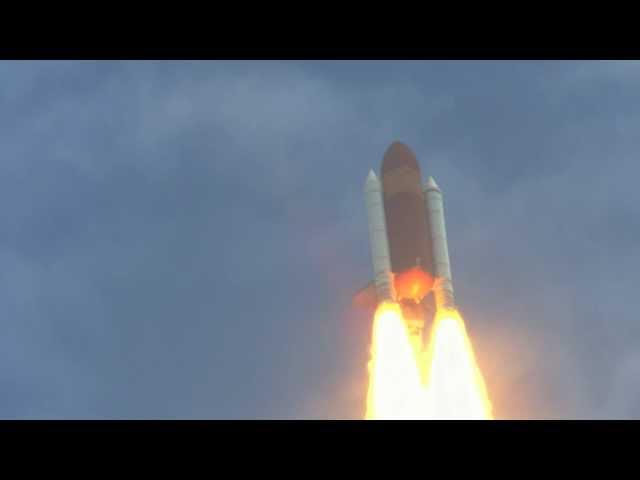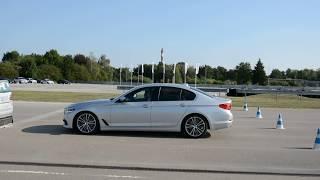
The Last Space Shuttle launch, STS-135, July 8, 2011
The camera was located 3.5 miles (5.6 km) from Pad 39A, at the Vehicle Assembly Building parking lot. I hand operated the shot, tracking the shuttle using an Oconnor 25-75 pan-tilt head.
Arri was invited to bring 3 cameras to Cape Kennedy to shoot the last Space Shuttle launch. I was asked by Arri to be the Cinematographer on the project. I traveled to Florida with Stephan Ukas-Bradley of Arri, 11 days before the launch to begin setting up two of the Alexa cameras, to be remotely controlled, placed 1,000 feet (300m) from Pad 39A.
We set up this third camera the morning of the shot, and with great anticipation, I shot the most spectacular event I have ever witnessed, as the Space Shuttle launched for the very last time, and traveled into history. It was 11 days of careful preparation, for 20 seconds of shooting.
Комментарии:

Absolutely amazing! Thanks for sharing the very nice video from the final launch of a Space Shuttle!
I really love it.
Can I share it on my YT channel ( Great SpaceX)?
I will credit you and link to your YT account here.
Hope that to share more meaningful news with the world man.
Is it ok?
Please let me know when you are available.
Thank you,
Kroos,

Hi Bill, do the ssme's perform the roll program?
Ответить
Absolutely amazing! Thanks for sharing the very nice video from the final launch of a Space Shuttle!
Ответить
Also, the Soyuz rocket DOES shake the cosmonauts some. You just can't see the vibration because it's at a Hertz frequency that is invisible to the human eye. Many Hertz frequencies of vibration are invisible to an unaided human eye and can't only be felt or heard to a human. That's pointed out in the Shenzhou 9 launch recently: /watch?v=oaDJCr-5T1U (starts at 3:30) Sorry but that was a bit of an amateurish comment. All rockets suffer from vibration loads. Solids from TO and liquids from Pogo.
Ответить
1) If any astronaut did say that I'm sure they were exaggerating for comedic effect. Robert L. Crippen talked about its bumpiness with a smile and compared it to "Dad's old Dodge". Nothing injurious. Many astronauts have ridden on it multiple times with no complaints. If you think the Shuttle is a rough ride you should have seen the Mercury-Redstone flights or the Gemini-Titan flights. Real space cowboy stuff. 2) What does this have to do with anything I just said?
Ответить
Watch a Soyuz flight from inside the capsule, it completely smooth on liquid engines. Then watch a Shutte. One Astronaut even said it shakes so hard it can knock your teeth out. Its the way the fuel burns in vortex's with solid fuel.
Ответить
Also, the flight test of the Ares I and DM ground tests showed that it shakes less than the Shuttle. By the end of 2009 TO was no longer a signifcant concern for the Ares rocket. NASA even announced they probably wouldn't need shock absorbers for the Ares. I could have sworn I told you that before. If I did and you remember then now you're just being intellectually dishonest for your own agenda.
Ответить
Where did you get that info about SRB vibrations cauing the foam to come off? Foam and paint chips come off EVERY rocket at launch. All rockets have vibration, liquid rockets are no different. Liquids tend to have POGO issues. It's just the degree which is from a combination of propellant type, the shape of the rocket and flight dynamics specific to the rocket.
Ответить
What no one ever wants to talk about why the foam came off. -Tabu topic. The foam from the external tank popping off was the direct result of SRB oscillation/vibration that is inherent only with solid fuel. Both SRB's strapped to the main tank cause major stress and vibration. Its why shuttle shook so hard until SRB sep where it became a smooth ride. Its also, why NASA had been working on a 2nd stage dampening system for Ares1 complete with shocks and springs before it was cancelled.
Ответить
Indirectly caused both Shuttle accidents? The SRBs had nothing to do with the Columbia incident. That was from foam from the external tank. Even in the Challenger incident the SRBs didn't blow up, the problem was a faulty O-Ring which had more to do with a localized problem. Not really an inherent design flaw in solid boosters. If you want to bash solid boosters the Titan IV incident is a better example to use. Solids blow up much bigger than liquids if they explode.
Ответить
That's why the Saturn V could lift more weight than the Soviet N1 rocket even though the N1's thrust was 40% higher. The N1 used Kerosene in all stages while the Saturn V only used Kerosene in the first stage and LH2/LOX in the second and third stage. Although declassified Soviet government info shows later versions of the N1 were supposed to use LH2 instead of kerosene. Had the Soviets flown a fifth N1 like they planned it might have worked. Falcon 9 currently uses kerosene in both stages.
Ответить
as the main propulsion system for a rocket other than maybe as a first stage or strap-on boosters to add extra lift for the first stage. Liquid and hybrid rockets are definitely preferable for second stage engines. Solids have been and still are used for final stage sustainer engines or escape velocity boosters though. SpaceX plans on using LH2/LOX mixtures for all stages in later rockets with the "Raptor" stage they're working on. Kerosene/LOX isn't quite as efficient.
Ответить
Liquid rockets are "safer" in that they can be shut off. There does exist advanced solid rocket boosters that can be throttled but I don't know of any that can be shut off once started (if there isn't now there may in the future). However, it is still possible to jettison a crew away from a solid booster rocket. I think solid boosters have exploded slightly less often than liquid boosters but liquid boosters are more controllable. Due to lower specific impulse solids aren't preferable
Ответить
Only partly true. What causes the Shuttle to vibrate and oscillate so hard is an exclusive issue caused directly from solid fuel. After, SRB-sep its a smooth ride. NASA was so concerned about SRB vibrations on Ares1 that NASA had been working on a damping system for the 2nd stage complete with springs and shocks since 2006. No one wants to talk about it, but the SRB's shook off the foam which struck the wing. ATK lobby power in the senate will not allow NASA to have a rocket w/out SRBs.
Ответить
Hmm, I did now know about the 2 missions with 8 people. SpaceX still has to develop an escape system, but it is already safer. Falcon9 also can turn off any of its 9 engines mid flight and still reach LEO. Shuttle had no escape system and could not turn off its SRB's once started. The Shuttle SRB's indirectly caused both Shuttle accidents. The Dragon capsule does not require return orientation or flight computers. Had shuttle lost its flight computers/power it would have been curtains.
Ответить
On 2 occasions, 8 astronauts have flown in the Space Shuttle (missions STS-61-A and STS-71). In case of an emergency rescue mission, the absolute maximum crew is 11, though that capability was never utilized. The SpaceX Falcon Heavy Lift vehicle has never flown. The Saturn V used in the Apollo program was more than twice as powerful, and flew over 40 years ago. It's hard to claim the Falcon9 is the safest ever, when it has yet to fly with people. Let's check again after 135 manned flights
Ответить
"7" is the most any Space Shuttle has ever carried and it max normal limit. Some missions only had a crew of 2. Based on cost 1.5 Billion p/Shuttle launch and 150-200 Million p/Soyuz launch, Soyuz carries much more weight. Shuttle was the most dangerous manned rocket ever created. By contrast, Falcon Heavy lifts over double that of Shuttle and is 100 Million p/launch. Falcon9 manned is also 100 million and carries 7 and is the safest manned rocket ever created.
Ответить
ti994apc The Soyuz is reliable, and can carry a crew of three to Low Earth Orbit (LEO). The Progress cargo variant of the Soyuz can lift 2,600Kg to LEO. Both types still fly today. The Space Shuttle could lift 25,000Kg, including 8 people to LEO, almost 10 times the mass, and return with a satellite if need be. The shuttle could carry 11 people in an emergency. They were reusable, where the Soyuz are a one-time use. The Shuttles are retired. Which is better? I guess it depends.
Ответить
Shuttle just looks so old, crude and early 70's. The solid rocket boosters look like a car running on bad gas. Soyuz, by contrast even know created before Shuttle is much more elegant, does not shake around, smooth, and really a more advanced space vehicle better suited for manned travel.
Ответить
KD0IDB, You are most welcome. It was interesting to see in slow motion, the shock waves traveling through the smoke and vapor, as the shuttle lifted off.
Ответить
That is infinitely gorgeous! Thanks you so much for sharing this video. I regret I could not have been at that launch, though I did watch it live on TV up here in Minnesota and it's a memory I will never forget! Again, a sincere thanks for sharing this video!!!
Ответить



![TEMPEST - I'll Be There Lyrics [Color Coded_Han_Rom_Eng] TEMPEST - I'll Be There Lyrics [Color Coded_Han_Rom_Eng]](https://ruvideo.cc/img/upload/czVCSld6ZHlDQXU.jpg)






![Keri Hilson - I Like [Official Music Video].mp4 Keri Hilson - I Like [Official Music Video].mp4](https://ruvideo.cc/img/upload/d3FBVTJja0hLbDY.jpg)














